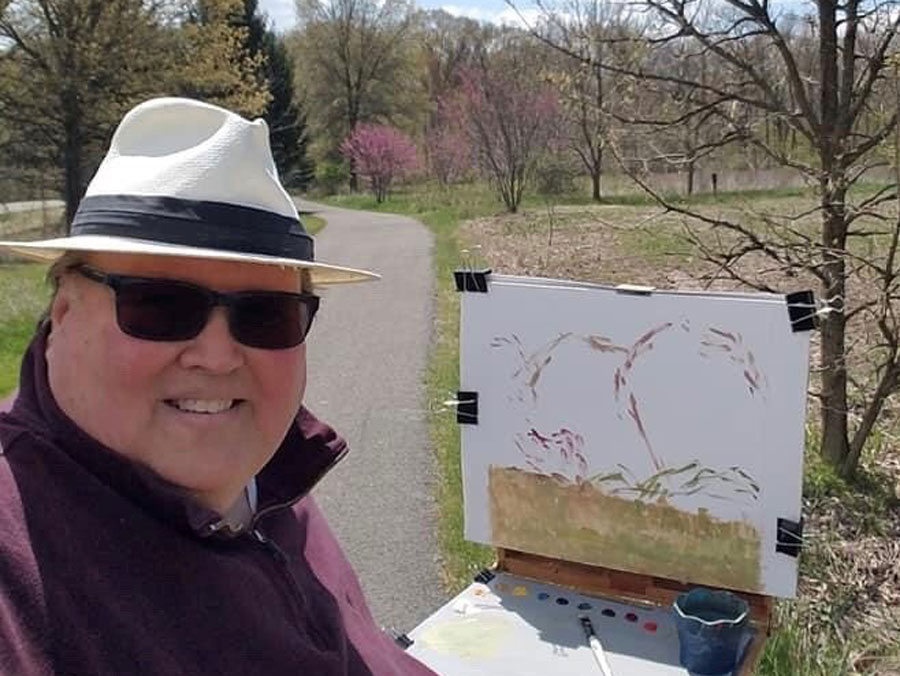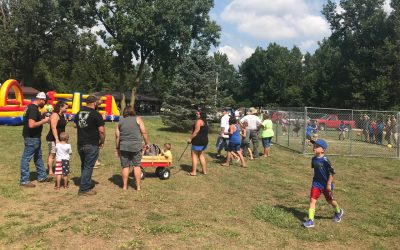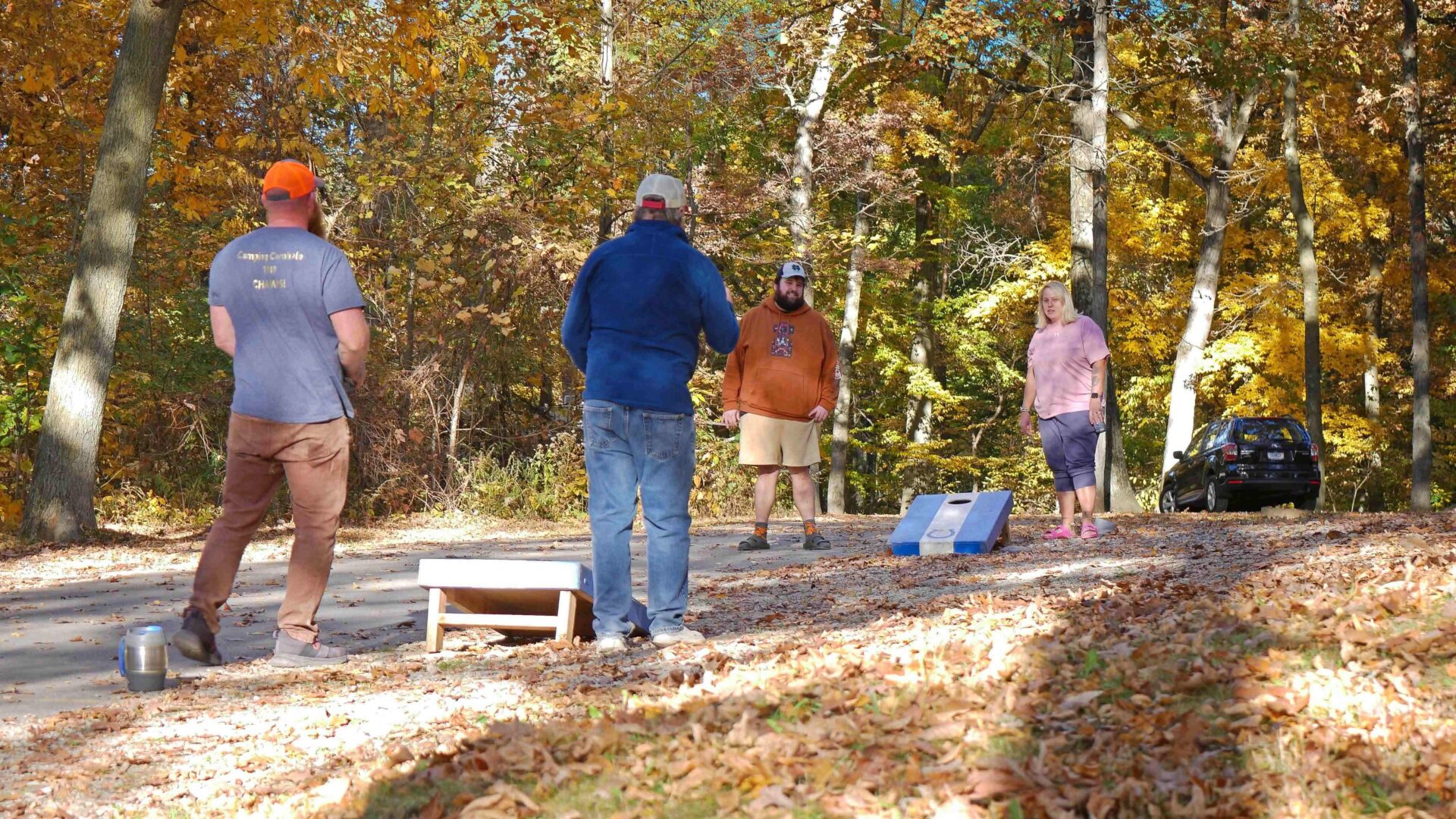Steuben County Soldiers’ Monument
In the middle of Angola’s impressive historic downtown stands Steuben County’s most important piece of public art: The Soldiers’ Monument.
In the middle of Angola’s impressive historic downtown stands Steuben County’s most important piece of public art: The Soldiers’ Monument. The soaring memorial rises proudly from the hill known to locals as “the mound,” creating a traffic circle in front of the county courthouse, city hall, shops and restaurants. It has stood as the unmistakable center of the county seat since 1917.
The mound was a city-owned circular public green space before the monument was constructed. In July 1916, the local post of the Grand Army of the Republic (G.A.R.), a Civil War veterans organization, petitioned the Steuben County Commissioners to build a Monument to honor those who served in the war a half century earlier. The city agreed to the use of the mound and in September the County Council appropriated $15,000 for the project. Financing was through the sale of bonds payable with 4 1/2% interest. A design submitted by J. M. Ayres, a Mansfield, Ohio architect, was selected. The construction contract was awarded with a completion date of August 1, 1917.
Construction progressed swiftly and the monument was completed on time. Contemporary newspaper reports tell of a grand dedication ceremony held on September 13, 1917 with large crowds, patriotic decorations, parades, music, veterans’ reunions, and speeches by notable local and national politicians and dignitaries.
The monument is made of substantial materials, primarily granite quarried in Vermont and set by an expert from Boston. Its design is a square-sided column rising from a graduated square base. Upon the monument are bronze plaques bearing the names of the 1,278 men of Steuben County who served, including the 280 who perished in the war. Four inscriptions are chiseled into the monument, one on each side of the lower base. They contain a record of the date of the monument, a remembrance of the courage of the women who persevered on the home-front during the war, a memorial to those who perished in service, and a quote from Abraham Lincoln’s Gettysburg Address.
Decorating the monument are five notable bronze statues. The largest, sitting atop the column and rising to 70 feet, is a classically robed 10 foot tall female figure holding a wreath with her outstretched left hand and supporting a flag draped on an 18 foot pole with her right hand.
Four smaller statues, one on each corner of the base, are life-sized depictions of servicemen in Civil War uniforms representing the various branches of military service. On one corner is an infantryman standing at parade rest with his pack-roll on his back and his rifle, stock resting on the ground, held before him. The navy is honored with a sailor holding an oar in one hand and his other hand held across his brow, shielding his eyes from glare, as he peers into the distance. An artillery soldier holds his unholstered side arm in his right hand and a long pole with the cannon sponge in his left. A cavalryman sporting a Hardee hat and spurs stands with his drawn curved-blade saber at the ready.
Unlike many war memorials, the statues are not solid cast bronzes or unique commissioned pieces. All five are made of hollow stamped bronze, a new budget-friendly technique at the time. They were purchased from the W. H. Mullins Company of Salem, Ohio. The Mullins Company manufactured an extensive line of architectural sheet metalwork – storefronts, garlands, urns, eagles, weathervanes, moldings, friezes – and even metal boats. They had become well recognized for their statuary products in stamped metal – either sheet copper or sheet bronze – from the manufacture of a famous statue of the roman goddess Diana designed by America’s top sculptor, Augustus St. Gaudens. The statue stood atop the tower of the 1893 Madison Square Garden.
The classical figure which tops the Steuben County’s Soldiers’ Monument was one of several similar designs offered by Mullins. It is officially named “Peace,” a most suitable figure to watch over our community.
As a result of the 50th anniversary of the Civil War in 1911-15, veterans’ monuments were popular projects across the country – in the north and the south. Traditional custom-commissioned cast bronze or sculpted stone statues were beyond the budget of many smaller cities and civic organizations. The W. H. Mullins Company produced a catalog in 1913 featuring its mass-produced statues. As the title suggests, “The Blue and The Gray” included designs for both Union and Confederate monuments. Included were a few statues of known persons (General Robert E. Lee, Major Joseph M. Morehead), but most offerings were anonymous figures costumed in the uniforms of their service. Forty-two pages are photographs of memorials in locations stretching from Maine to Florida to California, all featuring Mullins statuary. A Union Soldiers’ Monument in Rushville, Indiana is shown, a single plinth surmounted by a statue of an infantryman standing at parade rest – the same design as the infantryman on the Steuben County Monument. Many websites documenting monuments with the Mullins Company figures can be found.
The Soldiers’ Monument has been lovingly restored and improved in recent years and is ready for another century. The foreword to the Mullins Catalog best describes the importance of such monuments:
“Books of adventure and history, that record men in their deeds of heroism, may remain on their shelves, unopened to the present, younger generation, and those to come.
Flowers, on the mounds of the now silent heroes, wither and fade away.
But the permanent memorials that the living heroes erect, in commemoration of their deeds, and those of their fallen comrades, will withstand time and all elements.
They will stand in silence, but a visual reminder to this, and coming generations; to the throngs that pass in the activities of peace, who will remember and reverence, for all time, those who fought and fell in war.”
Pleasant Lake Days
Everyone was sitting at table cloth covered picnic tables under a pavilion so we sat down to enjoy...
Pokagon State Park
Pokagon is also home to the state’s only refrigerated toboggan. Open weekends the day after Thanksgiving through the last weekend in February, the toboggan is a great family activity.
101 Lake Sauce
101 Lakes Sauce is an “all purpose sauce good on everything except ice cream and cereal.” Purchase locally at Fremont Village Foods or the Bent Fork in downtown Angola. The sauce is also used on The Venue’s wings!
101 Lakes Pontoon Rentals
New pontoons with daily and weekly rentals. Will deliver to lake cottages or any public access site.
(260) 316-9152

Douglas Runyan is a retired lawyer, landscape painter and art collector who moved to Steuben County in 2018. He enjoys painting on location and in his Jimmerson Lake studio. He is known for his snow scenes and works depicting rural scenes, schooners and commercial fishing boats in pastel, gouache, oil and acrylic. His paintings have been accepted and received awards in more than 50 local, regional and state juried exhibits, including Indiana Heritage Arts, Hoosier Salon, Ventures in Creativity and Richmond Art Museum. Since Doug and his wife, Laura, moved to Jimmerson Lake, he has enjoyed painting local landmarks, Autumn and Spring scenes from the state parks and views of the lakes. He has studied art in workshops with national and regional painters and taught painting classes for Fort Wayne Artlink, Fort Wayne Artists Guild, and Steuben Arts Scene. He exhibits and sells his work at Castle Gallery in Fort Wayne, the Brown County Art Gallery and Indiana Heritage Arts Gallery in Nashville, and Folly Cove Fine Art in Rockport, Massachusetts. He has been guest curator for exhibits at the Fort Wayne Museum of Art, Brown County Art Gallery, and Garrett Museum of Art. His interest in art includes researching and writing about art history, particularly the artists of Indiana’s Brown County Art Colony and Massachusetts’ Cape Ann Art Colony. He has authored articles published in American Art Review, exhibit catalogs for Indiana Heritage Arts, and an essay on the Cape Ann paintings of C. Curry Bohm published in the book “C. Curry Bohm: Brown County and Beyond.” Doug is a lifetime member of the Fort Wayne Artists Guild, a board member of Steuben Arts Scene, and a member of Indiana Heritage Arts.










